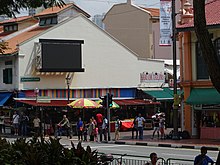Little India (Singapore)
Little India , located in the Rochor Planning Area , Singapore , is an ethnic district that is predominantly home to the city's Indian minority.
Location, name
Little India is roughly north of Kampong Glam , the settlement area for the Malaysian population of Singapore, and north of Chinatown , the Chinese quarter south of the Singapore River; the main street is Serangoon Road , and the border streets include Selegie Road, Jalan Besar and Lavender Street.
Little India is commonly known as "Tekka" in the Indian community of Singapore. The area was formerly called Tek Kia Kha by the Hokkien Chinese (abbreviated Tek Kah ), about "river of small bamboos" or "bamboo lumps"; Back then, bamboo plants grew on both sides of the Rochor Canal , which flows through Little India.
history
The Indian immigrants originally settled further south, where Chulia Street or High Street is today ("chulia" was derived from "chulier", residents of the old Chola Empire in Tamil Nadu who emigrated to many parts of the Malay Peninsula ). With the increase in population density there, a wave of resettlement towards Serangoon Road began in the 19th century, which continued after 1900.
Serangoon Road, which runs through the whole of Little India, is one of the oldest streets in Singapore. One of the oldest Hindu temples, the Sri Srinivasa Perumal Temple (built in 1885) is located here. At that time, a small number of Indian convicts were settling in Serangoon Road. They were held in the prison on Bras Basah Road, but were also allowed to live outside the prison.
The Rochor Canal, created in the 1830s, encouraged the development of cattle breeding in Little India, where they were also traded in and establishments such as slaughterhouses and dairy dealers. Its water fed the pastures where the buffaloes grazed. In the former district of Kandang Kerbau (in Malay about "cattle enclosure") there was also a small settlement Kampong Kerbau ("Buffalo Village" in Malay). Livestock farming reached its peak around 1900, after which it was scaled back because the buffalo herds were blamed for damaging the roads. The canal used to be an important waterway for the timber industry, and there were many sawmills and timber factories on its banks. Many Indians were hired and employed in these industries.
During the Japanese bombing raids before the actual Battle of Singapore during World War II , the first bombs fell on December 8, 1941, not far from Serangoon Road. The reconstruction after 1945, especially from the 1970s onwards, has made Little India one of Singapore's most famous tourist attractions.
Attractions
Little India has numerous attractions, here is a selection:
- is one of the oldest streets in Singapore and one that "stretches across the island"
- Little India Arcade
- it is a collection of shops, Ayurvedic practices, outlets with sweets, jewelry shops, etc.
- Masjid Abdul Gaffoor (Abdul Gaffoor Mosque)
- is one of the landmarks of the city; it has a sundial with Arabic calligraphy depicting the names of 25 selected prophets; it is unique in the Islamic world
- The Church Of True Light
- this 1850 Anglican church was open on Saturdays and Sundays from 9 am to 1 pm and previously served the Chinese congregation of Hock Chew and Hinghwa; on the pillars and walls there are Bible verses in Chinese
- Sri Veeramakaliamman Temple (Sri Veeramakaliamman Temple)
- was built in 1881 by well-known Bengali craftsmen and is dedicated to the Hindu goddess Kali, the wife of Shiva
- the foundation stone for the monument to Mahatma Gandhi was laid on June 18, 1950 by Jawaharlal Nehru on the occasion of his visit to Singapore
- Tekka Market (Tekka Market)
- the original goods market is now a lively market with fresh fruit and vegetables, meat and fish; at one end there is a large street vendors' center serving typical Singaporean street vendor dishes
traffic
The following MRT stations are in operation in the area: Little India , Farrer Park on the North East Line and Rochor and Jalan Besar on the Downtown Line .
Individual evidence
- ↑ a b c d e f g The Little India Heritage Trail (Little India Trail Booklet), ed. by the state's National Heritage Board, 85 pages, online at: roots.sg / ...
- ↑ The term 'Chulia' is a corruption of 'Chulier' , Portal Penang Happenings, April 18, 2017, online at: penanghappenings.com / ...
- ↑ Opalyn Mok: In crumbling tombstones, Penang's link to ancient Chola , portal of the newspaper, April 14, 2014, online at: malaymail.com / ...
- ↑ a b Melody Zaccheus: Take a walk through Little India's rich history , report in The Straits Times of January 25, 2017, online at: straitstimes.com / ...
- ↑ a b c Serangoon Road , in: Infopedia, Server of the National Library Board, Singapore Government, online at: eresources.nlb.gov.sg / ...
- ↑ District 08 - Little India, Farrer Park , website from iproperty.com.sg, online (archived) at: webcache.googleusercontent.com / ...
- ↑ Little India , in: Infopedia, Server of the National Library Board, Singapore Government, online at: eresources.nlb.gov.sg / ...
- ↑ Little India , article on the Uniquely Singapore portal, website of the state-run Singapore Tourism Board, online (archived) at: web.archive.org / ...


